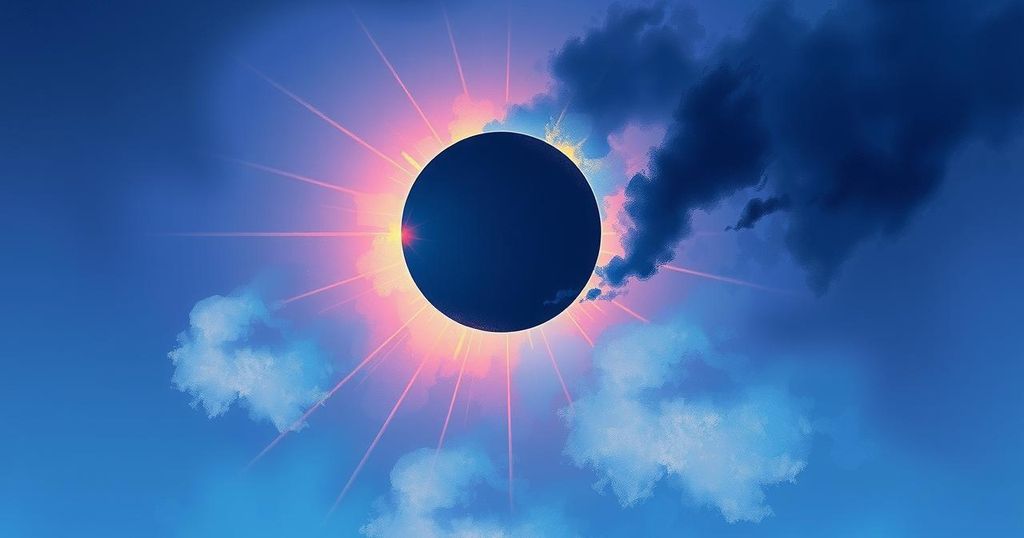Weather
AFRICA, ASIA, BURKINA FASO, CANADA, CLIMATE, COMMUNITY ENGAGEMENT, DOVER, EARTH, ENGLAND, EUROPE, GALLAN HEAD, GREENLAND, ICELAND, INDIA, JAPAN, MANCHESTER, NONE, NORTH AMERICA, NORTHERN ASIA, PA, RAIN, SCIENCE, SCOTLAND, SOUTH AMERICA, TECHNOLOGY, UK, UNITED KINGDOM, UNITED STATES, USA
Marisol Gonzalez
0 Comments
Partial Solar Eclipse 2025: Key Details and Viewing Safety
On March 29, 2025, a partial solar eclipse will occur, visible in parts of North and South America, Europe, and northern Asia, but not in India. The eclipse will last approximately four hours, with significant visibility variations in different regions. Safety precautions are critical, and NASA recommends using certified eclipse glasses for viewing. Google will feature a special animation illustrating the solar eclipse when searched. The event commences at 2:20 PM IST and peaks at 4:17 PM.
The first solar eclipse of 2025, known as Surya Grahan in India, will occur on March 29. During this event, the Moon will partially obscure the Sun, though they will not be perfectly aligned, leading to a partial eclipse visible in various regions, including the USA, Canada, Europe, and parts of northern Asia. Notably, this celestial event will not be visible in India.
Key details about the solar eclipse indicate that it will be one of 2025’s significant astronomical occurrences. Different regions will experience the eclipse at varying times, with some witnessing it at sunrise while others see it in the afternoon. In specific locations, such as the USA and Canada, observers may enjoy the unique double sunrise effect caused by the eclipse.
Regional variations will also affect the experience within the UK. For example, Gallan Head in north-west Scotland is expected to see approximately 47.9% of the Sun obscured, whereas Dover will experience only 28.1% coverage, indicating significant differences across locations.
Safety is paramount during the solar eclipse. It is essential to inspect eclipse glasses before use and ensure that they are not scratched or damaged. Children must be supervised, and using eclipse glasses with telescopes or cameras is strictly discouraged to prevent eye damage.
To safely view the partial solar eclipse, one should utilize certified eclipse glasses or a handheld solar viewer, as regular sunglasses do not provide adequate protection. Alternatively, indirect viewing methods, such as using a pinhole projector, can be an effective way to observe the event safely.
For those unable to view the eclipse directly, Google has created a special animation that highlights the solar eclipse event when the terms “solar eclipse” or “surya grahan” are searched, visually illustrating the phenomenon’s nature.
Directly viewing the Sun during any eclipse is hazardous. NASA emphasizes the necessity of using certified eclipse glasses or solar viewers, as traditional sunglasses fail to protect one’s eyesight.
The solar eclipse will unfold in various time zones worldwide. In much of the Americas, the eclipse will be observable at sunrise, while places in western Europe and northern Africa will see the event begin in the late morning. In contrast, eastern Europe and northern Asia will witness it during the afternoon.
The eclipse’s esoteric effects include the double sunrise phenomenon, where observers may perceive the Sun appearing to rise twice. This rare spectacle will delight those positioned to view it effectively. The event will commence in Indian Standard Time at 2:20 PM, peak at 4:17 PM, and conclude by 6:13 PM, lasting approximately four hours.
In conclusion, the March 29, 2025 solar eclipse presents an extraordinary opportunity for viewers across numerous regions, yet safety measures must be adhered to diligently. As it will not be visible in India, individuals in other areas can prepare to observe this remarkable natural phenomenon, which may include witnessing the double sunrise effect. Accurate planning for viewing times and the use of appropriate safety equipment will ensure a successful experience during this celestial event.
Original Source: www.hindustantimes.com




Post Comment